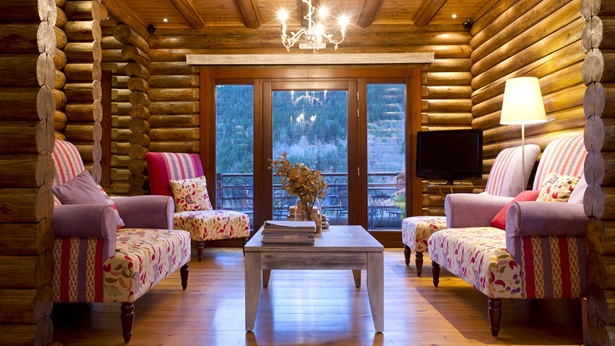Design Your Dream Home
The prospect of making your dream home a reality is a joy that is unparalleled. But it’s likely you have some anxieties as well. That’s why we created The Perfect Path to Your Dream Home to help home buyers make smart choices when buying and building.
The Log and Timber Homes Council, which sponsors this site, offers these FREE strategies to help you along the path to your new home. (To discover other ways that Log and Timber Homes Council protects buyers and their investment during this process, click here.)
Once you locate land and determine your budget, you can begin designing your new home. We encourage you to devote a lot of time and careful thought to this process. You will have to balance your lifestyle needs and desires, with your budget.
Create a Digital Scrapbook of Ideas
Pictures, as the saying goes, are worth a thousand words. Visit the photo galleries of the companies that belong to the Log and Timber Homes Council. Start collecting photos of the features you like, for each room in your floor plan. This research will help clearly convey your dream home to a member of the Log and Timber Homes Council.
Dreaming is Free
Before you dive into the nitty-gritty details of your project, take some time to daydream about design. Peruse floor plans and design catalogs offered by Log and Timber Homes Council members. Home design is a fascinating subject and one can spend hours absorbing the subtle nuances in each floor plan. Plus, a plan that has been built before can be an excellent jumping off point to create that custom design, just for you. Most Log and Timber Homes Council members have designers and engineers on staff to create a unique floor plan. Manufacturers also work with independent architects and designers. Or they can create a floor plan from a sketch of your own design.
Are Designs Copyrighted?
Although dreaming is free, home designs may not be. Floor plans may be copyrighted. Any restrictions on duplicating plans are usually stated with the plans, on the website or at the beginning of the printed publication in which the plans appear.
Tour Model Homes, Factories
Many members of the Log and Timber Homes Council have model homes at their log milling facilities (or located nearby). Additionally, manufacturers market their homes through independent builder/dealers across the United States, who may have model homes or live in a log and timber home themselves. Investigating these display homes will give you an idea of what you like in log and timber home design and construction.
Questions to Ask Yourself
As you peruse designs, start to ask yourself some basic questions:
- What kind of design will fit with the topography of our building site?
- What type of design do we want: single-story ranch, 1-1/2 story, split-level, two-story?
- Will our new home have a basement or crawl space? Or will it be built on piers or a slab?
- How many square feet will we need?
- How many bedrooms do we want?
- How many baths?
- Do we need any special areas for our hobbies or toys?
- How about a home theater, a custom kitchen or exercise room?
- How much storage space will we need?
Start a ‘Rather’ List
Create a “rather” list, i.e., “I’d rather have this, rather than that.” This will help establish priorities as you work on your design and budget. Top three “must have these” features in my dream log and timber home:
Top three “these would be neat to have” features in my dream log and timber home:
Top three “love these, but my lender will likely disapprove” features in my log and timber home:
Break It Down by Area
Make sure your floor plan includes activity areas for the following:
- Work Areas: home office, kitchen, laundry, pantry
- Sleeping Areas: bedrooms, bathrooms
- Living Areas: living room, dining room, family room, guest bath
- Storage Areas: basement, garage, out-buildings
Kitchens
- Most kitchens are designed around a “work triangle” (stove, sink, fridge) to save steps
- “U” shape is most efficient
- Both “U” and “L” shapes work well with an island
- Parallel- or single-wall layouts are least efficient
- Minimum 8′-10′ overall counter space
- Counter space (18″ minimum) beside latch side of refrigerator
- Counter space (24″ minimum) on either side of sink
- Counter space (18″ minimum) on either side of range
- At least 18 square feet of general storage, perhaps more if you belong to one of those big box stores that sell in vast quantities
- Will you need additional kitchen storage elsewhere? (Freezer, extra fridge)
Bedrooms
- Master bedrooms on the main level are now common (Aging boomers don’t want to tackle stairs)
- How many other bedrooms will you need?
- Don’t get caught up in terminology, think flexibility
- Bedrooms can be a home office, exercise room, study, for hobby or craft, game room
- To classify them as bedrooms (for resale value) many building codes require they have to be equipped with a closet
- Use closets for sound barriers between rooms
- Do you want private baths or will one bath be shared?
- Where will laundry be in relationship to master bedroom? (How far will you have to lug your clothes?)
Bathrooms
- Minimum bath sizes are 5’x7′ for a full bath; 4’x5′ for a half bath; 3’x3′ for a shower
- Larger bathrooms are more comfortable, increase resale value
- Stacking bathrooms above or below each other on first and second floors will save you money (less plumbing costs)
- Back-to-back bathrooms on a single-floor design also saves money (less plumbing)
- Plan for linen closet(s), storage, traffic patterns
- Extra amenities you may want: hot tubs, dry sauna, steam rooms and bidets (all require more square footage)
Laundry and Utility Areas
- To save on costs and square footage, you can combine a mudroom and laundry room
- Plan for plumbing, electrical and other infrastructure needs for these rooms
- Create counter space for tasks, such as folding laundry or gardening cleanup
- Consider task lighting for these rooms
- Consider if machine noise or vibration from these rooms will negatively impact living areas, including living room and master bedroom
Closets and Storage Areas
- If you are wondering if the closet in your new home will actually be large enough to meet your needs, measure the space you are using in your current home.
- A closet designer can help you with a custom design based on the combination of your current needs and any built-ins, such as hampers, drawers or shelving
- This type of planning will let you know up front if your closet size is adequate
- You will also get an idea of cost that you can use for budgeting purposes
- Extra hall closets cost little but provide efficient storage
Garages and Carports
- Most common two-car garage door size is 16 feet wide and 7 feet tall.
- Will handle two mid-size vehicles
- Measure your vehicles and toys (boat, camper, RV, etc.) to ensure your new garage will have enough space
- Will your garage will be attached, detached or joined to the home by a breezeway?
- Where will your most common entrance be? At front, rear or side of house?
- Ensure there is enough room for turning and parking vehicles
Porches and Decks
- These serve as important transition areas to and from the outside world
- They can also protect your logs against the wrath of Mother Nature, reducing maintenance costs
- Outdoor kitchen and patio combinations are increasingly popular, as places for entertaining
HVAC or Heating, Ventilating and Air Conditioning
- What are the energy or fuel options for your building site?
- Options include electric baseboard, electric radiant ceiling heat, forced air electric, gas, oil or propane, heat pump, stoves (wood or coal) and solar (active or passive)
Fireplaces and Woodstoves
- The old fashioned masonry fireplace is romantic — but expensive
- Masonry fireplaces cost many thousands more than modern factory-built, zero-clearance units
- Masonry fireplaces can be energy inefficient
- Try placing your fireplace or woodstoves in a central space, to distribute heat to the most used areas of the home



